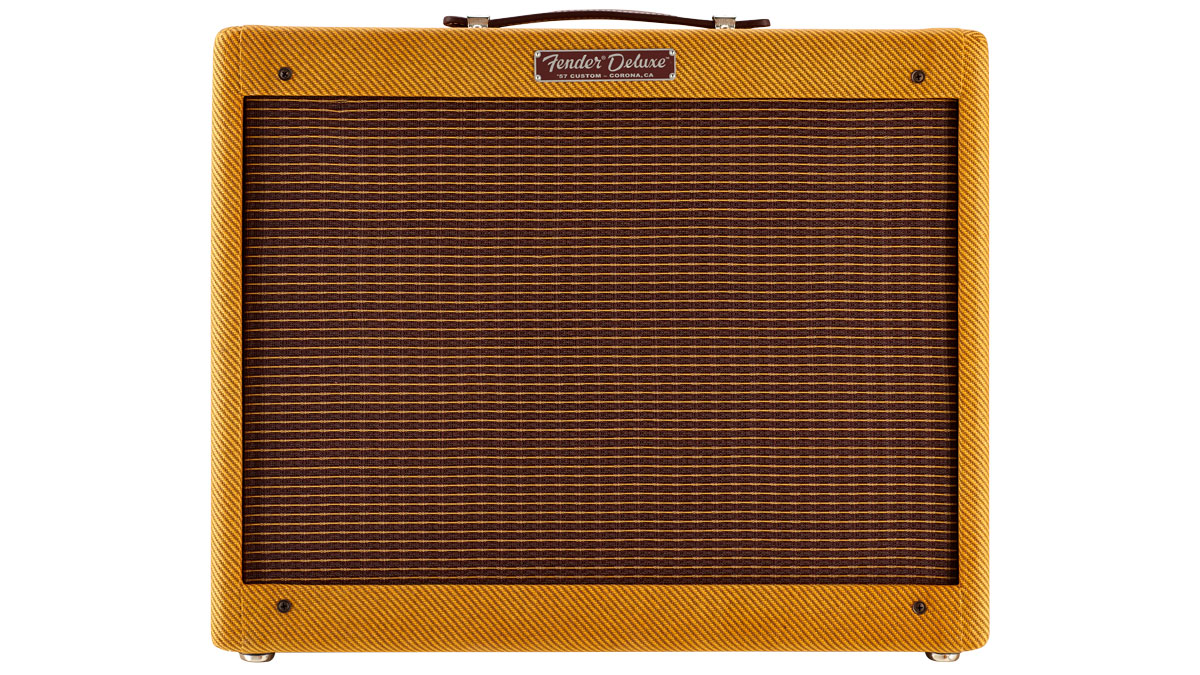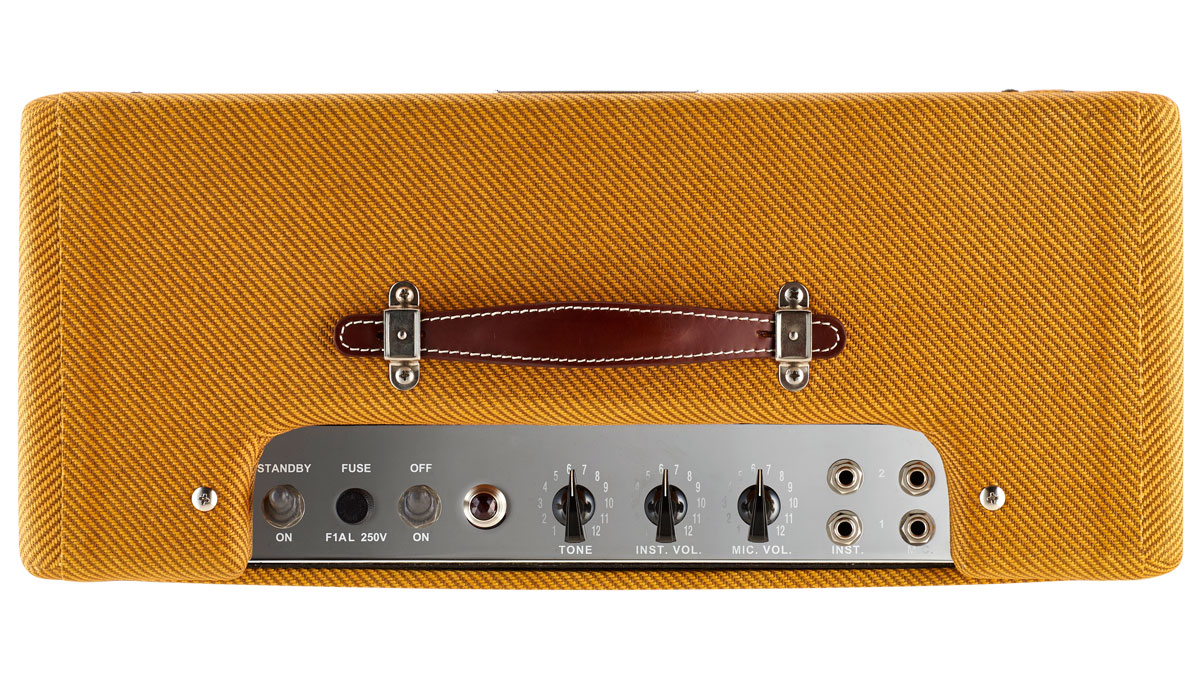MusicRadar Verdict
The Deluxe reproduces tones with great authority, and plenty of volume to handle small gigs.
Pros
- +
A wide range of tones from the deceptively simple controls; perfect volume level for small clubs and pubs.
Cons
- -
Expensive.
MusicRadar's got your back

Fender '57 Custom Tweed Deluxe

Fender '57 Custom Tweed Deluxe
From 1955 to 1957, Fender made what would become some of the last changes to its so-called 'tweed' amplifier range, to arrive at the coveted narrow panel series that went on to become the template for so many other designs.
The Bassman also changed from a 1x15 cabinet to a 4x10 in 1955, serving as the inspiration for another well-known amplification icon.
However, despite the temporary fashion for big stacks and 100-watt tops, the small tweed Fender has remained indispensable, providing the tonal inspiration for countless gold albums and hit singles. Over the years, Fender has reissued both amps in various guises, but this year the company has chosen to push the boat out with a Summer NAMM debut of not one, but four Custom Shop tweed amps of which this one, the Tweed Deluxe, is likely to be a runaway hit.
The combo is as close as can be faithful replica of their original 1957 counterpart.
The cabinet is finger-jointed solid pine, with expertly fitted cotton twill covering, gold/brown grille cloth, period-correct badge, leather strap handle and metal glide.
The chassis is chrome-plated steel, with slotted side panel to improve strength and assist in ventilation. Chickenhead knobs that go up to 12 adorn the control panel.
Inside, the electronics are fairly close to the original, using a black eyelet board to support all the small components, with neat hand wiring to the valve bases and front and rear panel connections.
The control panel is as simple as ever: the Deluxe gets two pairs of sockets for its interactive instrument and microphone channels, plus separate channel volumes and a master tone control. The valve complements are authentic, too, with a 12AY7 in the V1 positions and 5Y3 rectifier valves.
With the exception of a few safety changes, such as no cloth-covered hook-up wire, both combos look like they just rolled off the old Fullerton production line.
Sounds
The amp powers on with minimal background hum and hiss. Valve-rectified circuits take a little time for all the voltages to stabilise and after a few minutes the hum reduces to more than satisfactory levels. Both are fitted with a 12AY7 in the V1 position, which improves clean headroom at the expense of overall volume.
This is the original valve specification, but many guitarists prefer to use the higher gain and more commonly available 12AX7, which will cause the amp to break up earlier, typically well under the halfway point on the volume control.
We tried out the amp with a variety of single-coil and humbucking guitars and, in simple circuits like these, the guitar has a very strong influence on the amp's behaviour and the character of individual instruments is more noticeable.
Our Les Paul, for example, produced plenty of sustain and drive with both amps using a 12AX7 at lower volume settings, while a Strat fitted with regular low-ish output single coils still managed a respectable crunch.
Crank up the Deluxe with a decent Les Paul and you're in blues-rock central, with a fat midrange, toothy overdrive and harmonic-laden sustain that's instantly familiar and very responsive.
The microphone and instrument inputs on the Deluxe have quite different sounds; the instrument input has a generous treble boost, while the mic input is quite flat. We tried this with an archtop jazz guitar and got an authentic bebop tone with just a hint of growl (very Barney Kessel).
However, crank up the Deluxe with a decent Les Paul and you're in blues-rock central, with a fat midrange, toothy overdrive and harmonic-laden sustain that's instantly familiar and very responsive.
The Deluxe's volume controls are interactive because of the way the circuit is designed, so there's a wide range of tones to be had with different combinations, and you can jumper the inputs as well. The reworked volume control pot tapers also help to make the Deluxe more controllable at higher levels.
This amp nails many classic lead sounds, which is hardly surprising as it was often used to record them. From Larry Carlton's epic Kid Charlemagne and Don't Take Me Alive solos on Steely Dan's Royal Scam album, to Billy Gibbons' trademark 'edge of the pick' harmonic squeals, this Deluxe is a stunner.
It's taken a long time for this legendary amplifier to reappear in Fender's catalogue. Together with the Custom '57 Pro, Champ and Twin, they're part of a quartet that promises unearthly tone for all who want to experience the thrill and fun of owning a real vintage amp, without the pitfalls and fragility of 60-year-old electronics.
And that's the key thing. Vintage amplifiers don't age gracefully. Capacitors dry out and short-circuit, the insulation on old transformer windings isn't resistant to overheating, while repeated hot/cold cycling can open up dry solder joints and overheated resistors can drift from their true value. And then there's the mains voltage - original tweeds are configured for USA power, and in stock configuration they're not properly earthed.
Now, hunting down and owning vintage amps is fun, but we'd never want to rely on one that's been around for six decades when on stage. So, if you're in the market for a vintage tweed combo, owning one that's every bit as good as the original but built to modern standards and set up for our mains voltage is really a no-brainer.
“I actually specifically remember making a deal with myself": Billie Eilish reveals what she had to do in order to become “looser and jazzier” with her vocal delivery
“These guitars travel around the world and they need to be road ready”: Jackson gives Misha Mansoor’s Juggernaut a new lick of paint, an ebony fingerboard and upgrades to stainless steel frets in signature model refresh
“I’m surprised and saddened anyone would have an issue with my performance that night”: Zak Starkey explains why he got fired from The Who









